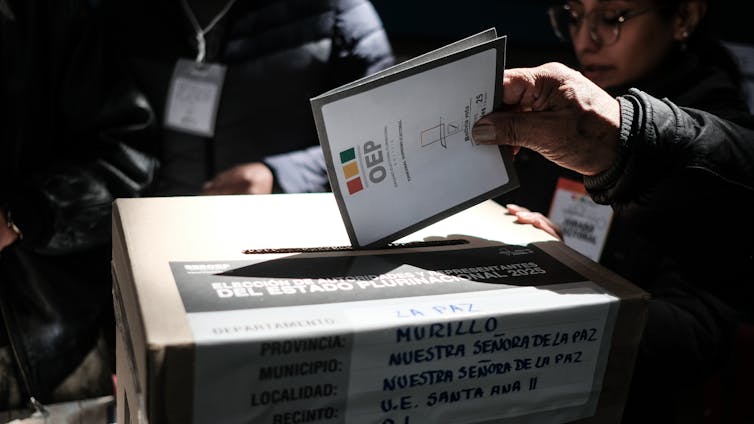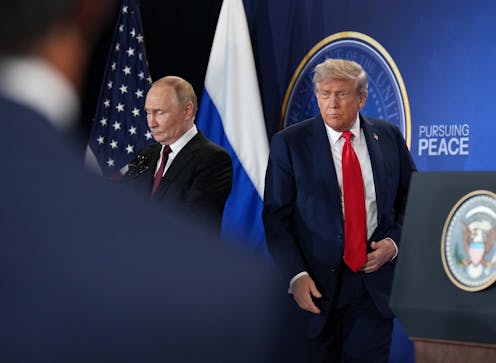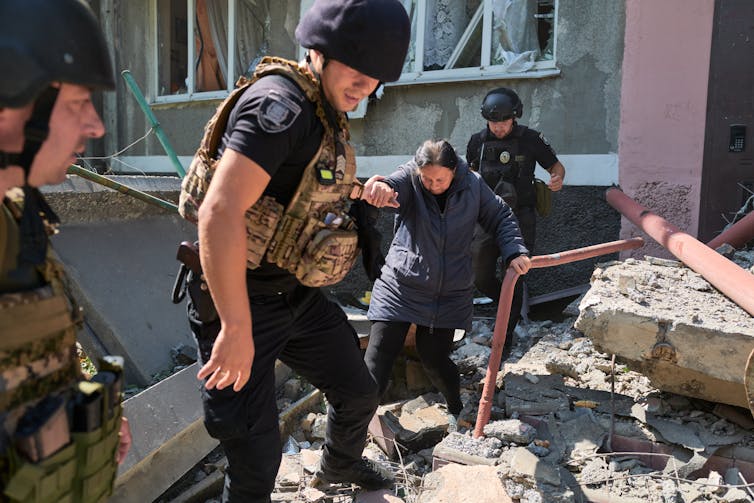Source: The Conversation – Global Perspectives – By Ronald Suny, Professor of History and Political Science, University of Michigan
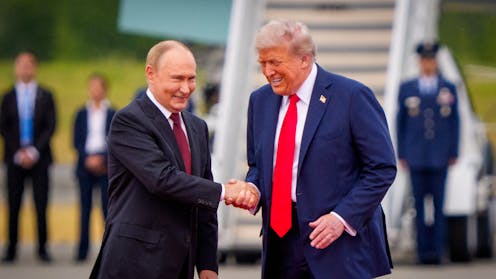
For all the pomp and staged drama of the summit between Presidents Donald Trump and Vladimir Putin in Alaska, the substantive part of the spectacle – that is, the negotiations between two great powers over the grinding war in Ukraine – did not at first appear to yield much. There was no deal and little detail on purported areas of progress.
The post-Alaska analysis, however, suggested the U.S. had shifted away from Ukraine’s position. Trump, it was reported, essentially agreed to Putin’s call for territorial concessions by Ukraine and for efforts toward a conclusive peace agreement over an immediate ceasefire – the latter opposed by Putin as Russia makes gains on the battlefield.
Those apparent concessions were enough to prompt alarm in the capitals of Europe. A hastily arranged follow-up meeting between Ukraine President Volodymyr Zelenskyy – and assorted European Union allies – and Trump in the White House on Aug. 18 yielded vague promises of security guarantees for Ukraine.
This is all very frustrating for those looking for some concrete foundations of a peace deal.
Yet, as a longtime scholar of Russian and Soviet history, I believe that the diplomatic whirl has revealed glimpses of what a future peace deal may look like. Or, more precisely, what it looks like for Putin and Trump.
It may be a bitter pill for Ukraine to swallow, but what it all suggests is a meeting of minds between the leaders of the two great powers involved: Russia and the United States. After all, as Trump told Fox News following the Alaska summit: “It’s good when two big powers get along, especially when they’re nuclear powers. We’re No. 1 and they’re No. 2 in the world.”
Known knowns and unknowns
Some of what we already knew remains unchanged. First, the European powers – notably Germany, France and the U.K. – remain fully supportive of Ukraine and are prepared to back Kyiv in resisting the Russian invasion and occupation.
Second, Zelenskyy opposes concessions to Russia, at least publicly. Rather, Ukraine’s leader seemingly believes that with Western – and most importantly, American – arms, Ukraine can effectively resist Russia and secure a better end to the conflict than is evident at this moment. Meeting Trump again in the Oval Office after being ambushed by Trump and Vice President JD Vance in February, Zelenskyy was as deferential and grateful to the U.S. president as his more formal dress indicated.
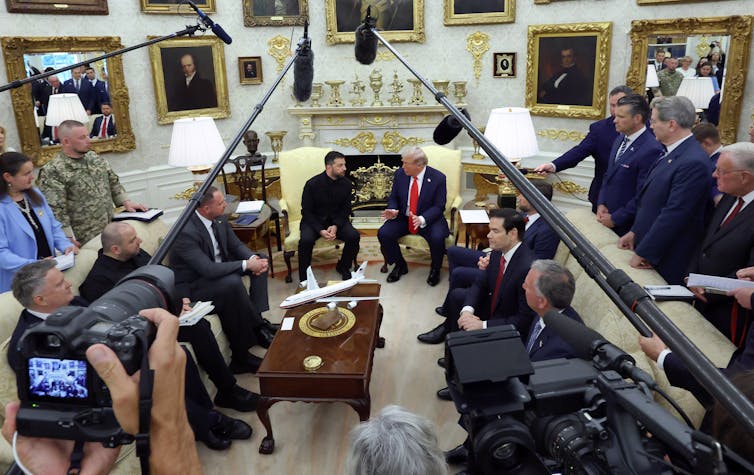
Anna Moneymaker/Getty Images
In contrast to Zelenskyy and the European powers, the aims and positions of the United States under Trump appear to be fluid. And while Putin talks of the need to address the “primary causes” of the Ukraine conflict and publicly pushes a maximalist position, it isn’t entirely clear what he will actually settle for in regard to the security and land arrangements he says he needs.
The imperial mindset
I would argue that there are two ways of interpreting the aims of both the United States and Russia: “imperial” and “hegemonic.” The former stems from an understanding of those countries’ long experience as empires. Countries that have descended from empires have memories of former greatness that many wish to repeat in the present.
And while there is nothing fatalistic about such imperial fantasies that translate the past into the present, they often echo in the repertoire of the influential and powerful.
There are signs in the rhetoric of both Trump and Putin of such grandiose imperial impulses. Both have talked of returning their country to a “great” past and have harbored desires of annexing or dominating other countries.
And many Western analysts of Russia are convinced that Putin dreams of becoming another Peter the Great, who expanded his empire into the Baltic region, or Catherine the Great, who sent her armies south into “New Russia” – that is, what is today Ukraine.
Hegemonic thinking
But there is also another way, short of empire, that explains how great powers act in the world: as hegemons, either regionally or globally.
Instead of the colonizing of other territories and peoples, hegemons act to dominate other countries economically and militarily – and perhaps ideologically and politically, as well. They do so without taking over the smaller country.
The United States, through its dominant position in NATO, is a hegemon whose sway is paramount among the members of the alliance – which can hardly operate effectively without the agreement of Washington.
Putin’s interests, I would contend, are short of fully imperial – which would require complete control of Ukraine’s domestic and foreign policy. But they are flagrantly hegemonic. In this reading, Putin may well be satisfied to get what the Soviets achieved in Finland during the Cold War: a compliant state that did not threaten Moscow, but remained independent in other ways.
Putin has such an arrangement with Belarus and might be satisfied with a Ukraine that’s not fully sovereign, militarily weak and outside of NATO. At the Alaska summit, Putin not only mentioned Ukraine as a “brotherly nation,” but also emphasized that “the situation in Ukraine has to do with fundamental threats to Russian security.”
One can read Putin’s words in many ways, but his public comments in Alaska framed the Ukraine conflict in Russian security terms, rather than in imperialist language.
Are negotiations possible?
The problem for Putin is that Russia does not have the economic and military power, or the reputational soft power attraction, to become a stable, influential hegemon in its neighborhood. Because it cannot achieve what the U.S. has accomplished through a mix of hard and soft power since the fall of the Soviet Union – that is, global hegemony – it has turned to physical force. That move has proved disastrous in terms of casualties, domestic economic distress, the mass migration of hundreds of thousands of Russians opposed to the war, and isolation from the global capitalist economy.
What Putin desires is something that shows to his people that the war was worth the sacrifices. And that may mean territorial expansion in the annexation of four contested provinces of Ukraine – Luhansk, Donetsk, Zaporizhzhia and Kherson – as well as Crimea, taken in 2014. That goal certainly seems imperial.
And while the distinctions between an imperial foreign policy and a hegemonic one may seem semantic or academic, they are crucial when looking at the prospects of peace. Imperialism is always about conquest and total subordination of one regime to another.
If indeed Putin is an imperialist who wants full control of Ukraine – or, as is often claimed, its elimination as a sovereign state and the recreation of a polity akin to the Soviet Union – then negotiation and compromise with Russia become impossible.
My sense is that to solidify his relations with Trump and his territorial gains in Ukraine, Putin will be satisfied with accepting the rest of Ukraine as a nation-state that remains outside of NATO and is neither a base for Western powers nor a perceived military threat to Russia.
The problem here, of course, is that such a solution may be unacceptable to Zelenskyy and would have to be imposed on Kyiv. That would be anathema to the major European powers, though not necessarily for Trump.
And here we find another obstacle to peace in Ukraine: Europe and the U.S. do not have a united position on the final solution to the war. Even if both accept the view that Russia’s aims are primarily about its own idea of security rather than conquest or elimination of Ukraine, would Europe accept Putin’s demands for a major overhaul of the military balance in east-central Europe.
Trump appears less concerned about the prospect of a truncated Ukraine subordinated to Russia. His major concerns seem to lie elsewhere, perhaps in the Nobel Peace Prize he covets. But the United States may have to guarantee the security of Ukraine against future Russian attacks, something that Trump has hinted at, even as he abhors the idea of sending American troops into foreign conflicts.

Serhii Masin/Anadolu via Getty Images
Realism at odds with a just peace
Wars have consequences, both for the victorious and the defeated. And the longer this war goes on, the more likely the grinding advance of Russia further into Ukraine becomes, given the military might of Russia and Trump’s ambivalent support of Ukraine.
With those realities in mind, the solution to the Russia-Ukraine war appears to be closer to what Russia is willing to accept than Ukraine. Ukraine, as Trump so brutally put it, does not have cards to play in this tragic game where great powers decide the fate of other countries.
We are back to Thucydides, the ancient Greek founder of political science, who wrote: “Right, as the world goes, is only in question between equals in power, while the strong do what they can and the weak suffer what they must.”
Not surprisingly, this is what international relations theorists call “realism.”
![]()
Ronald Suny does not work for, consult, own shares in or receive funding from any company or organization that would benefit from this article, and has disclosed no relevant affiliations beyond their academic appointment.
– ref. Alaska summit and its afterlife provides a glimpse into what peace looks like to Putin and Trump – https://theconversation.com/alaska-summit-and-its-afterlife-provides-a-glimpse-into-what-peace-looks-like-to-putin-and-trump-263309




